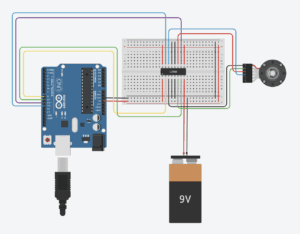Introduction
For today’s recitation i was tasked to build a circuit which incorporated an H bridge, a stepper motor, and the use of external power.
Materials
1 * 42STH33-0404AC stepper motor
1 * L293D ic chip
1 * power jack
1 * 12 VDC power supply
1 * Arduino kit and its contents
2 * Laser-cut short arms
2 * Laser-cut long arms
1* Laser-cut motor holder
2 * 3D printed motor coupling
5 * Paper Fasteners
1 * Pen that fits the laser-cut mechanisms
Paper
Circuit 1: Stepper Motor

This specific circuit was hard to create because of the amount of wires that were involved, as well as the added risk of breaking the Arduino if the circuit wasn’t wired correctly because of the added external power. At first when I built the circuit, it would not function. In order to figure out why, I rearranged the wiring in order to organize the circuit to look exactly like the diagram, however all the wiring was correct. Then I switched out the stepper motor as it could have been a possible cause of the problem. The circuit still did not work. I then switched out the H bridge and the circuit started to work.
The added external power was in order to make the stepper motor function properly. Motors in general require more power than the Arduino can provide.
Circuit 2: Drawing Machine
For this aspect of the activity, I worked with a partner who had built the same circuit as me. We added a potentiometer to the circuit in order to control the rotation of the stepper motor, and then added 3D printed arms that were provided to us in order to create the drawing machine.
Questions:
1) Machines I’m interested in building
- Actuators are responsible for converting forms of energy into motion. Because of this, actuators can be an essential component of creating new interactive forms of media and art. One way I could see actuators being used is in the world of music. Although most instruments are appealing at face value due to the beautiful sounds that they produce, they can sometimes become monotonous to younger children as they have to play the same songs over and over again while learning the groundworks of musical theory. In order to make the process of learning more engaging to a younger audience, I would like to create a machine that translates physical movement with the whole body into a machine that uses actuators in order to play an assortment of different musical instruments.
2) Art installation
- Daniel Rozin has a line of artwork which focuses on showing reflections using ordinary objects, blurring the lines between digital and physical. An example of this is his Wooden mirror, which takes visual input and translates it into his piece. The artwork reads grayscale information, and tilts wooden panels hung up on a wall in order to reflect more or less light, according to the greyscale input. I think Daniel chose stepper motors for each of the wooden panels as a greyscale input could be translated to an exact angle that the panel should be turned to. This relates to the work during this recitation as we used potentiometers in order to control stepper motors. A physical characteristic (movement) was translated to digital data through the potentiometer, and then translated back into the physical world using the stepper motor and the drawing arms. The wooden mirror uses physical visuals, translates them into data, which is then shown again physically through the tilting panels on the wooden mirror